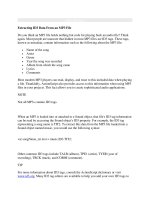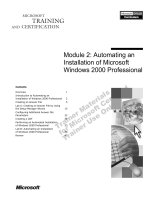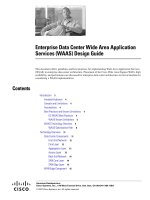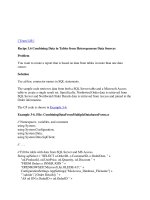Tài liệu Retrieving Data from an Oracle Package ppt
Bạn đang xem bản rút gọn của tài liệu. Xem và tải ngay bản đầy đủ của tài liệu tại đây (17.77 KB, 5 trang )
[ Team LiB ]
Recipe 2.20 Retrieving Data from an Oracle Package
Problem
Given an Oracle package that returns multiple result sets for related tables as REF
CURSOR data types, you want to access this data using a DataReader and load the data
into a DataSet.
Solution
Use the data type OracleType.Cursor .
The sample code creates a Command for an Oracle package CURSPKG that takes a
Customer ID input parameter. The package calls a stored procedure that returns two
result sets—Orders and Order Details data from Northwind for the specified customer—
as Oracle REF CURSOR output parameters.
A DataAdapter is created from the Command, retrieves the Orders and Order Details
result sets, and loads them into a DataSet. A relation is created between the tables and the
default view for the Orders table is bound to the data grid on the form.
Next, a DataReader is created from the Command. The Orders and Order Details result
sets are displayed in a text box.
The Oracle package is shown in Example 2-27
, and the package body is shown in
Example 2-28
.
Example 2-27. File: Packages\CURSPKG
CREATE OR REPLACE PACKAGE CURSPKG
AS
TYPE T_CURSOR IS REF CURSOR;
PROCEDURE GetCustomerOrdersWithDetails (
pCustomerID IN CHAR,
curOrders OUT T_CURSOR,
curOrderDetails OUT T_CURSOR);
END CURSPKG;
Example 2-28. File: Package Bodies\CURSPKG
CREATE OR REPLACE PACKAGE BODY CURSPKG
AS
PROCEDURE GetCustomerOrdersWithDetails
(
pCustomerID IN CHAR,
curOrders OUT T_CURSOR,
curOrderDetails OUT T_CURSOR
)
IS
V_CURSOR1 T_CURSOR;
V_CURSOR2 T_CURSOR;
BEGIN
OPEN V_CURSOR1 FOR
SELECT * FROM ORDERS
WHERE CustomerID = pCustomerID;
OPEN V_CURSOR2 FOR
SELECT * FROM ORDERDETAILS
WHERE OrderID IN
(SELECT OrderID FROM ORDERS WHERE
CustomerID = pCustomerID);
curOrders := V_CURSOR1;
curOrderDetails := V_CURSOR2;
END GetCustomerOrdersWithDetails;
END CURSPKG;
The C# code is shown in Example 2-29
.
Example 2-29. File: OracleRefCursorsForm.cs
// Namespaces, variables, and constants
using System;
using System.Text;
using System.Data;
using System.Data.OracleClient;
// . . .
// Create the connection.
OracleConnection conn = new OracleConnection(
ConfigurationSettings.AppSettings["Oracle_ConnectString"]);
// Create the command for the Oracle package.
OracleCommand cmd = new OracleCommand( );
cmd.Connection = conn;
cmd.CommandType = CommandType.StoredProcedure;
cmd.CommandText = "CURSPKG.GetCustomerOrdersWithDetails";
// Add the parameters.
cmd.Parameters.Add("pCustomerID", OracleType.Char, 5);
cmd.Parameters.Add("curOrders", OracleType.Cursor).Direction =
ParameterDirection.Output;
cmd.Parameters.Add("curOrderDetails", OracleType.Cursor).Direction =
ParameterDirection.Output;
// Set the Customer ID parameter value to user entry.
customerIdTextBox.Text = customerIdTextBox.Text.ToUpper( );
cmd.Parameters["pCustomerID"].Value = customerIdTextBox.Text;
// Create the DataAdapter and table mappings.
OracleDataAdapter da = new OracleDataAdapter(cmd);
da.TableMappings.Add("Table", "ORDERS");
da.TableMappings.Add("Table1", "ORDERDETAILS");
// Fill the DataSet from the Oracle package.
DataSet ds = new DataSet( );
da.Fill(ds);
// Create a relation.
ds.Relations.Add("ORDERS_ORDERDETAILS_RELATION",
ds.Tables["ORDERS"].Columns["ORDERID"],
ds.Tables["ORDERDETAILS"].Columns["ORDERID"]);
// Bind the default view for the Orders table to the grid.
dataGrid.DataSource = ds.Tables["ORDERS"].DefaultView;
// Create the DataReader from the Oracle package.
conn.Open( );
OracleDataReader dr = cmd.ExecuteReader( );
// Output the Orders table for the customer.
StringBuilder result = new StringBuilder("ORDERS" + Environment.NewLine);
while(dr.Read( ))
{
for(int i = 0; i < dr.FieldCount; i++)
result.Append(dr[i].ToString( ) + "; ");
result.Append(Environment.NewLine);
}
// Move to the REF CURSOR for the next result set.
dr.NextResult( );
// Output the Order Details for the customer.
result.Append(Environment.NewLine + "ORDER DETAILS" + Environment.NewLine);
while(dr.Read( ))
{
for(int i = 0; i < dr.FieldCount; i++)
result.Append(dr[i].ToString( ) + "; ");
result.Append(Environment.NewLine);
}
conn.Close( );
// Output the result.
resultTextBox.Text = result.ToString( );
Discussion
You cannot use a collection of SQL statements as a batch query within an Oracle stored
procedure. Instead, you must use an Oracle package, that is, a container that groups
stored procedures and functions. An Oracle package consists of a header and a body. The
package header defines the name of the package and provides method signatures for each
procedure or function in the package. The package body contains the code for the stored
procedures and functions defined in the package header.
A REF CURSOR is an Oracle data type that points into a result set
returned by a query. A REF CURSOR differs from a normal cursor in
that while a cursor points to a specific result set, a REF CURSOR is a
variable that can point to different result sets—a reference to a
cursor—and can be assigned at execution time.
A REF CURSOR is typically used to pass result sets from a stored
procedure to a client.
You can access a result using an output parameter that references an Oracle REF
CURSOR. The parameter name must match the name of the REF CURSOR and it must
have the data type OracleType.Cursor.
If the package returns more than one REF CURSOR parameter, an OracleDataReader
accesses them in the order they were added to the parameters collection. The NextResult(
) method of the DataReader advances to the next REF CURSOR.
[ Team LiB ]









